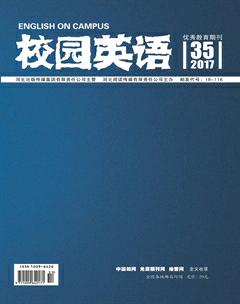Strategies and Methods of Chinese Characteristic Vocabulary Translation
李亞男
【Abstract】Chinese characteristic vocabulary is a tool for expressing specific things. Language translators studied correct translation of Chinese characteristic vocabulary from aspects of adaptation and context theory, but they ignored cultural conflicts between countries, which caused many mis-translations of Chinese characteristic vocabulary, affecting understanding of target language users. In this paper, the author introduces some knowledge of Chinese characteristic vocabulary, analyzing causes and provides strategies for translation.
【Key words】Chinese Characteristic Vocabulary; Translation; Strategy; Method
The Chinese characteristic vocabulary is a particular thing for expressing Chinese culture. It is difficult to translate Chinese characteristic vocabulary into English. In this passage, the author takes Chinese characteristic vocabularys translating into English for example and introduces some methods. By these ways, we can basically understand how Chinese characteristic vocabulary is shifted to satisfy need of communicating in English. Firstly, the author lists some reasons which cause difficulty of translation.
1. The Vocabulary Vacancy
Languages have vocabulary vacancy and cultural differences are manifested in belief, and other acquisition habits. Such as Chinese generations of emperors regarded “dragon” as symbol of authority. However, in West, “Dragon” is a symbol of evil. This is a traditional accumulation, different understandings causing vocabulary vacancy.
2. Regional Difference
Its caused by geographical location. The han ethnic people live in Asian continent cant live without land. So Chinese vocabulary are close to land But in Britain, shipping developed well, so English words are related to sea;For example, Chinese use “collapse” to describe collapse, but Englishmen use “get into hot water” to express difficulty.
3. Custom Differences
The custom differences of English and Chinese are embodied in many aspects, such as diet, marriage, and so on. For example, Chinese people think red represents good luck. While westerners think red represents violence. So the phrase “a red day” should be “a white day”. This example can be regarded as custom cultural differences caused by lexical vacancy.
Translation is not only a transformation between languages, but also an integration between cultures. We should keep Chinese cultural connotation to make foreigners understand.To solve translation difficulty, the author lists three methods of translating Chinese characteristic vocabulary.
1. Transliteration
It is more commonly used in translating introduction of technical terms, person, place and product names plus other proper nouns. For instance, “tea” was originated in pronunciation of “tea” of South Fujian dialect to the world which keeps semantics Chinese cultural characteristics and adapt to language communication environment.
2. Literal Translation
It keeps forms, especially the metaphor, image of original text without against language norms of text. For example, “鐵飯碗”can be translated into “iron rice bowl”;“紅包”can be translated into “red packet”;“開放政策” into “open door policy”;These not only express content of original phrases but also preserve metaphor of original terms.
3. Meaning translation
It needs translating plain meaning. Such as “proprietary technology”, “Land of fish and rice” etc. But many foreign words lack context, thus causing mistranslation;CD Chinese explanation for laser discs, but the full name of CD should be “Compact disk”. It is difficult to associate phrase with laser mentioning the words compact, lightweight, single level.
Language is an important tool of human communication. However, languages cant fully carry all world cultures. Nowadays, English is undeniably becoming an international language. So, we should strive to energetically spread study of Chinese civilization and characteristic vocabulary, if the Chinese characteristic vocabulary translation is proper, the expression of specific things in China will play a unique role and further enhance Chinas status in international affairs.
References:
[1]B.Kachru.The English Language Today.Institutionalized Second-language Varieties.Oxford:Pergamon Press,1985.
[2]Chunyan XIANG.On Translation Strategies of Chinese Culture-Loaded Words.Canadian Social Science.2016:(69-74).
[3]Chunyan XIANG.On Chinese Translation of English Interjections.Cross-Cultural Communication.2016:(15-20).
[4]Jingjing Cui.On the Translation of Chinese Current Political New Words.Theory and Practice in Language Studies.2012: (1075-1079).
[5]Larry A.&Richard E.Porter.Communication Between Cultures.Beijing:Beijing Foreign Language Institute of Education,1993.

